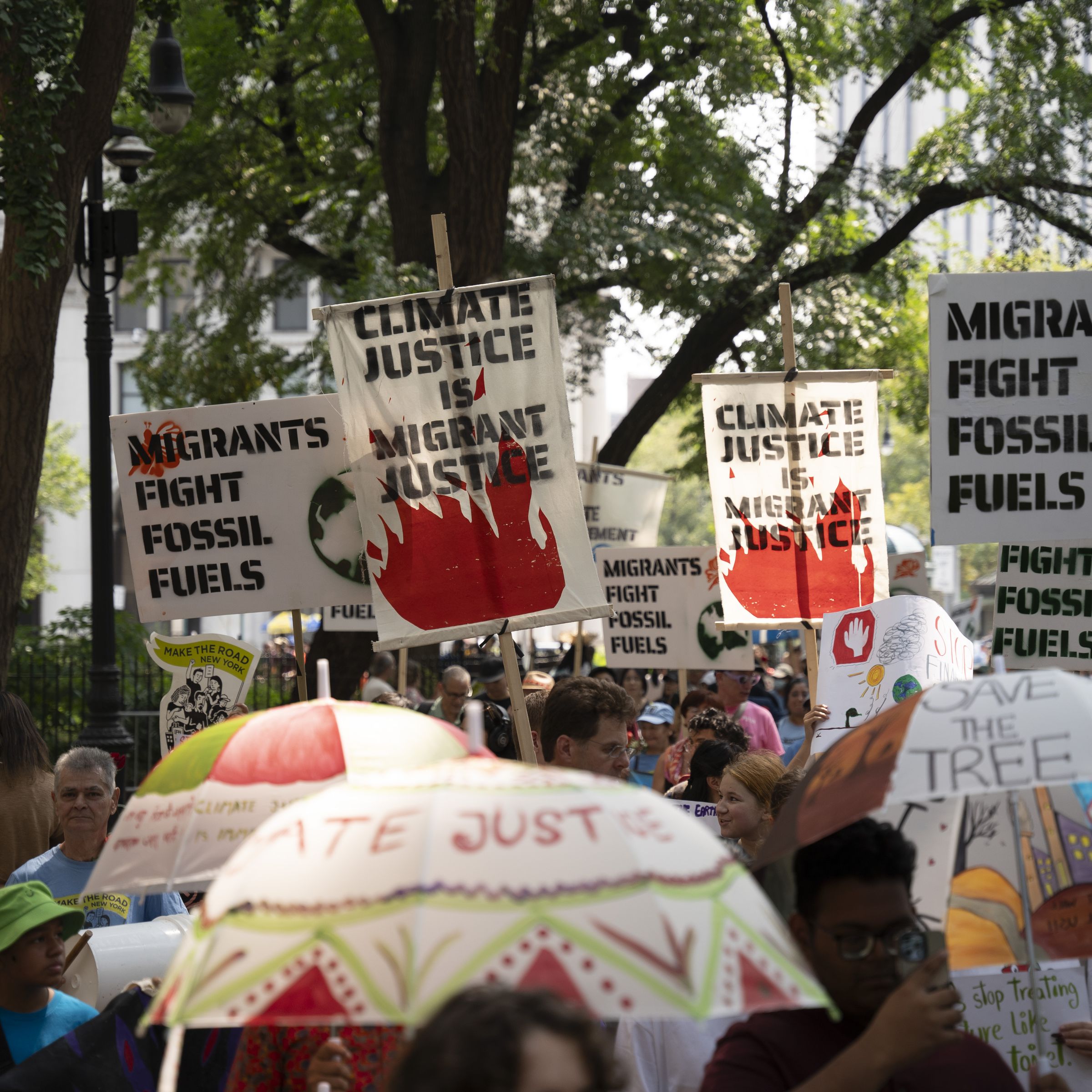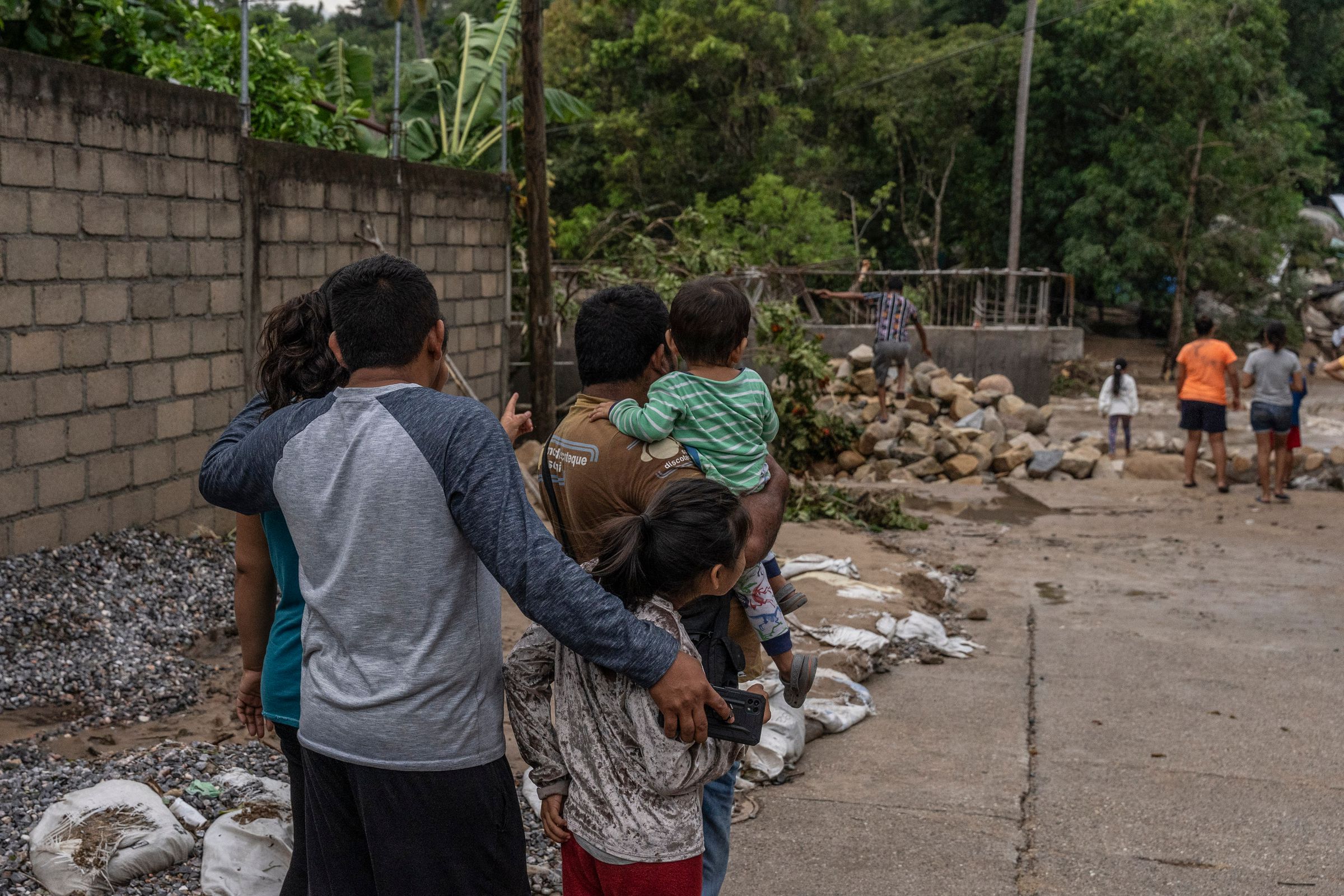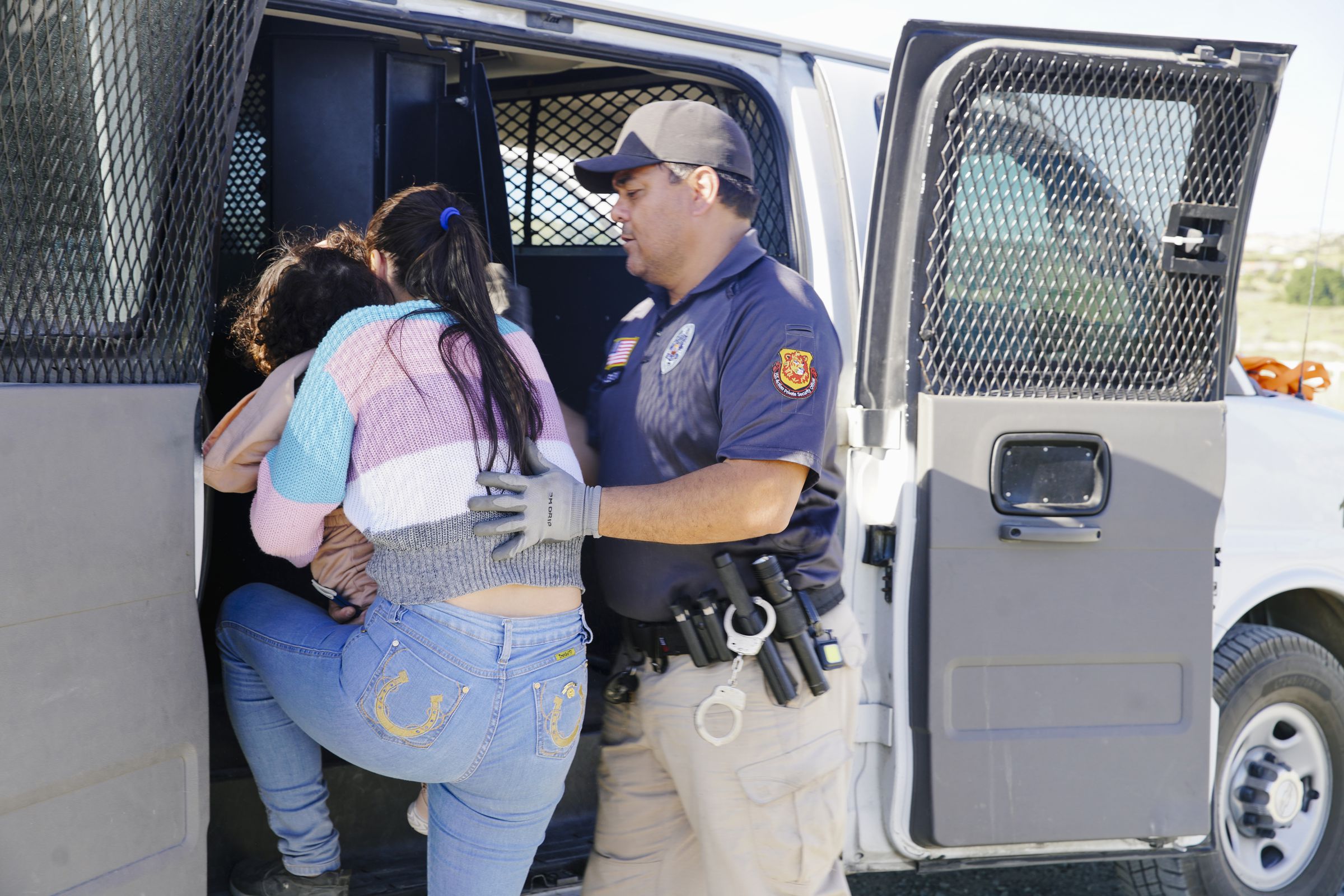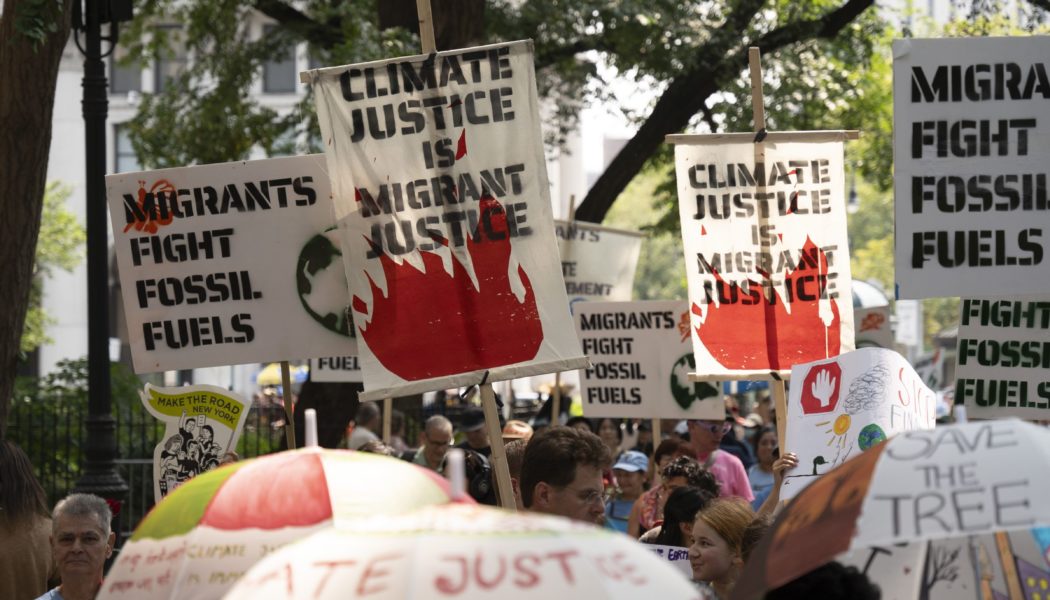Joe Biden raised hopes that the US would finally plan for climate-displaced migrants. Today, it’s still a glaring hole in climate and immigration policy.
Share this story

Joe Biden will leave office having taken more action on climate change, arguably, than any US president before him — but one pillar of his climate plan has fallen apart. Climate-driven disasters have displaced millions all over the world, an issue Biden acknowledged early in his term yet did little to address. But as climate change and migration are becoming increasingly intertwined, US policy is anything but prepared.
Without any explicit legal protections for climate migrants, the US continues to have a giant blind spot as it abandons those fleeing ecological disaster. Where Democrats have under-delivered — and, in some cases, moved to the right — on border issues, Republicans seek to entirely upend the immigration system, dismantle asylum altogether, and strip away environmental regulations. Former President Donald Trump has promised to pull the US out of the Paris agreement, an international treaty to stop global warming. Vice President Kamala Harris has pledged to continue the Biden administration’s climate initiatives and his tougher stance on the border.
“What’s coming up for me is deep heartbreak,” says Ama Francis, climate director at the International Refugee Assistance Project (IRAP). “There’s been this push towards more xenophobic immigration policies across both sides of the aisle. That has significant implications for who the United States considers itself to be — but also for how people can seek safety as we live in these times where our climate is changing and borders are becoming even more violent places.”
Under current national climate policies, “the best we could expect to achieve is catastrophic global warming,” the United Nations recently warned. Already, disasters push some 25 million people from their homes each year — typically more than the number displaced by conflicts or violence annually, according to the Internal Displacement Monitoring Centre. In 2023, only one-quarter of those disasters were related to earthquakes. The rest were wildfires, droughts, storms, floods, or weather-related events. Climate change is making each of those problems worse, strengthening hurricanes, raising sea levels, and setting the stage for explosive blazes with hotter, more arid conditions in many parts of the world.
While the majority of people move to another part of the same country afterward, worsening environmental disasters can compound other factors that might eventually lead to international migration. A storm that wipes out crops or knocks down someone’s home could be the final straw that makes it untenable for someone to stay. Other disasters might be more drawn out and could exacerbate other crises. Struggles over dwindling resources can spark larger conflicts, one reason why climate change is often described as a “threat multiplier.”
Over the past year, IRAP and several other organizations that provide legal assistance to US-bound migrants surveyed more than 3,600 people of the individuals they’ve helped. The survey found that 43 percent of the people said they’d experienced some sort of climate-related disaster in the country of origin they left. The most common challenges people faced were severe rainfall and flooding, hurricanes, and extreme heat.


“Hurricane Otis blew off the entire roof of our houses, and with everything exposed to the elements, everything was damaged and spoiled, including the loss of crops,” said a 39-year-old man from Guerrero, Mexico, in the report. The devastation added to other personal losses; the man says his brother was murdered amid ongoing violence in the region where organized crime has had a deadly foothold.
A 24-year-old woman from Guerrero, meanwhile, talked about drought affecting her home. “Due to lack of water, we did not have good harvests, which is what we rely on in Guerrero,” she said in the report.
While climate change might not be the only or even main reason why someone has to leave their home, its footprint is clear in these kinds of stories. Hurricane Otis intensified more rapidly than nearly any other tropical storm on record before making landfall as a Category 5 hurricane in October 2023, becoming one of the costliest disasters of its kind to hit Mexico. Research conducted after the storm determined that heavy rainfall from Otis was “mostly strengthened by human-driven climate change.” Separate research also suggests that climate change will “significantly increase the risks that already vulnerable subsistence farmers’ face in the present” across regions of Mexico where many people grow their own food, including Guerrero.
These kinds of experiences are becoming more common, but climate change remains largely unacknowledged in US immigration policy. In the US, the only policy that carves out protections based on environmental catastrophes is called Temporary Protected Status, or TPS. The Secretary of Homeland Security can designate a country for TPS if there are “conditions in the country that temporarily prevent the country’s nationals from returning safely, or in certain circumstances, where the country is unable to handle the return of its nationals adequately.” That includes environmental calamities like hurricanes and earthquakes.
TPS safeguards people from those countries from deportation and allows them to legally work in the US. But as the name suggests, it’s temporary and doesn’t give someone a path to permanent residency or citizenship. Moreover, only people already in the US prior to TPS designation are eligible — it doesn’t extend to new arrivals. The policy is also vulnerable to the whims of each presidency; Trump tried to roll back TPS designations during his first term in office as part of his broader crackdown on anyone seeking refuge in the US. (A similar policy, called Deferred Enforced Departure, gives individuals from certain countries temporary reprieve from deportation if their country of origin has been affected by civic conflict or environmental disasters.)
Biden seemed to reverse course upon stepping into office, issuing executive orders saying he’d undo restrictive Trump-era immigration and asylum policies. An executive order in February 2021 directed the Assistant to the President for National Security Affairs to produce a report that would include recommendations for how to recognize, protect, and resettle people “directly or indirectly” displaced by climate change.
“We were so excited,” Francis says. “There was a sense that this administration was really engaged on this issue, and there was this opening to really push the needle forward.”
But Biden’s attempts at undoing Trump’s most harmful immigration policies quickly gave way to a harsher stance on the border. In the end, Biden’s rightward pivot on immigration did little to appease his right-wing critics and only disappointed the migrant advocates who helped get him elected in 2020.
During his first two years in office, Biden kept one of Trump’s most stringent border policies in place: a pandemic-related asylum shutdown called Title 42. Under Title 42, migrants who arrived at the US-Mexico border could quickly be “expelled” to Mexico without a hearing. Customs and Border Protection continued its expulsion policy under Biden but also began granting exemptions to asylum-seekers who met certain criteria. When the Biden administration attempted to end the expulsion policy in 2022, a federal judge blocked it from doing so.
By the time Title 42 expulsions ended in the late spring of 2023, the public sentiment had largely shifted on immigration — and so had that of Biden’s administration. Title 42’s end was coupled with a new policy punishing migrants for attempting to enter the US without authorization. Under the administration’s “Circumvention of Lawful Pathways” rule, most migrants could be denied asylum for crossing the border between ports of entry, even if they would have otherwise been granted protection in the US.


At the same time, Biden dramatically expanded TPS and created new parole programs for migrants from Cuba, Haiti, Nicaragua, and Venezuela, as well as for people fleeing the war in Ukraine and the Taliban’s takeover of Afghanistan. The parole grants, however, are only valid for two years, and DHS officials recently said the department would not renew parole for Cubans, Haitians, Venezuelans, or Nicaraguans after the programs expire. As of August, more than 530,000 people from the four countries had entered the US via parole.
Biden’s expansion of temporary migration programs notwithstanding, there are still no dedicated immigration policies for people fleeing climate change-fueled disasters. And while Harris has previously acknowledged that climate change helps drive unauthorized migration, her campaign hasn’t commented on the link between the two; instead, she’s promised to continue Biden’s crackdown at the border.
Congressional efforts to help people affected by climate change overseas resettle in the US have stalled. Congress has not voted on the Climate Displaced Persons Act, a bill introduced by Rep. Nidya Velázquez (D-NY) and Sen. Ed Markey (D-MA) that would create a new visa category for those forced out of their countries of origin by climate disasters, allowing up to 100,000 immigrants to be admitted into the US each year.
Given the fact that Senate Republicans killed a bill limiting asylum because they believed it wasn’t restrictive enough, such legislation is unlikely to pass in the immediate future. If Trump wins the presidential election, there’s virtually no way the US will expand the criteria for asylum or refugee status. In his last year in office, Trump set the annual refugee limit at just 15,000 — the lowest in history. The administration had reportedly considered not admitting any refugees into the country at all.
“President Trump has been very clear on where he stands on this issue,” says Ahmed Gaya, the director of the Climate Justice Collaborative at the Partnership for New Americans. “We would once again face far more extreme restrictions on the legal rights, safe pathways, and on legal immigration, as well as a promise for the largest deportation operation in history.”
In other words, while there’s no negotiating with Trump, advocacy groups may be able to convince Harris to use existing policies to grant protections to climate migrants.
If elected, Harris could grant parole to people from countries affected by hurricanes, floods, earthquakes, and other disasters. She could designate TPS to those countries as well, so undocumented immigrants already living in the US could be shielded from deportation. None of these policies would guarantee that climate migrants have a permanent future in the US, but they would be a start.
Regardless of who is in office in 2025, immigration lawyers can also fight for asylum within the confines of the current law — and they’re already doing so.
Under the Refugee Act of 1980, someone who wants asylum or refugee status has to prove that they face persecution in their country of origin due to their race, religion, nationality, political opinion, or membership in a particular social group, an expansive category that even immigration attorneys say is difficult to define. The “particular social group” category is a fairly amorphous one, and some immigration judges have interpreted it generously: for example, it has been used to grant asylum to people fleeing gangs or intimate partner violence. This category’s vagueness also leaves it vulnerable to narrow interpretations. The Trump administration prohibited immigration judges and officers with US Citizenship and Immigration Services from granting migrants asylum on these grounds, a decision that was reversed under Biden. IRAP’s report includes several examples of environmental activists and land defenders who were granted asylum after being persecuted for their advocacy.
Taking swift action on climate change, of course, is what it’ll take to prevent displacement in the first place. That includes the US, the world’s biggest historical polluter of planet-heating carbon dioxide, slashing its emissions. Activists from less wealthy countries — including low-lying island nations most vulnerable to sea level rise and strengthening storms — have also pushed for international funds to help their communities recover and adapt.
“I think there need to be a host of options available, and one of those is supporting the right to stay safely in one’s community, knowing that most people do wish to stay,” says Jocelyn Perry, senior advocate and program manager of the climate displacement program at Refugees International.
For many people around the world, though, the option to stay is washing away with rising tides or dissipating in the heat. Looking back on their initial excitement after Biden’s executive order on climate migration and what little progress there’s been since then, Francis says, “I think we, like others, were disappointed.”









